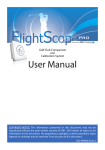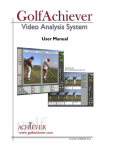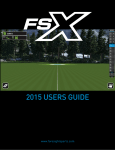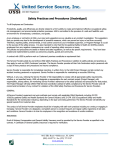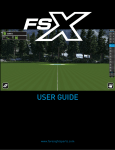Download OWNER`S MANUAL SWING SPEED RADAR®
Transcript
OWNER’S MANUAL SWING SPEED RADAR ® MODEL NO. SSR364 Congratulations............................................................................2 Features & Benefits..................................................................... 2 Using the Swing Speed Radar®................................................... 3 Golf Mode.................................................................................... 4 Baseball & Softball Mode............................................................. 5 Specifications.............................................................................. 7 Emission & Safety Standards....................................................... 7 Care of Your Swing Speed Radar®............................................... 8 Problems/Troubleshooting........................................................... 8 Battery Insertion.......................................................................... 8 Warranty and Service.................................................................. 9 RoHS 0123 Congratulations on purchasing your SWING SPEED RADAR®. If used and cared-for as described in this Manual, you should enjoy many hours of fun and constructive use. FEATURES & BENEFITS The Swing Speed Radar® is a small inexpensive microwave Doppler radar velocity sensor that measures the swing speed of golfers and baseball/softball players. It assists players in developing/optimizing their swing by providing a convenient measure of their swing velocity as they strive to improve their performance. Increased swing speed corresponds to increased ball distance for a squarely hit ball. However, over-swinging can produce inferior results, as suggested by the advice — “it’s not how hard you swing but how well you swing”. Players can measure their swing speed; determine their speed for optimum performance; monitor their swing consistency; and select the club or bat characteristics that best suit their swing. Golfers can determine their optimum swing for best distance, control and accuracy. Baseball and softball players can develop their optimum bat speed for distance, quickness, and bat control for consistent ball contact. The Swing Speed Radar® conveniently provides real time velocity feedback that assists players and coaches/instructors in measuring performance improvement and in trouble-shooting swing mechanics. Clever design results in a small, versatile low-cost device affordable for players of all skill levels. A nylon drawstring pouch and two snaphooks are provided to facilitate carrying the Swing Speed Radar®, attaching it to your equipment bag or other accessory case, or hanging it on a net or fence for bat swing speed measurements. The pouch will protect the lens from scratches during normal handling and storage. 2 USING THE SWING SPEED RADAR ® (Example) MPH km/h Golf Mode 90 Miles Per Hour ready FUNCTION BUTTON Polarity Of AA Batteries (Battery Cover Removed) Simple one-button operation turns the electronics “on”, allows selection of golf or baseball/softball modes; and a choice of velocity readings in miles per hour (mph) or kilometers per hour (km/h). The Swing Speed Radar® is microprocessor controlled, like a mini-computer, and indicates calculated velocity on a three-digit liquid crystal display. Clubhead or bat speeds can be measured from 30 to over 200 mph, or about 50 to over 320 km/h. Powered by three AA batteries (not included), the Swing Speed Radar® transmission characteristics are well within FCC requirements and prescribed safety levels. The radar electronics are designed to automatically go into a sleep mode after five minutes of inactivity, to conserve battery energy. The steps involved in operating the Swing Speed Radar® are: 1. Insert AA batteries, observing correct polarity. All segments of the display will light briefly. 2. Press and release the Function Button. Radar will turn on in the Golf mode, mph units. Radar transmission is indicated by the illuminated “READY” bar on the display. Smaller bars are lit next to the mph and Golf symbols. 3. Momentarily pressing and releasing the Function Button while the READY bar is lit will toggle the radar between mph and km/h; and also between Golf and Bat speed modes. The functions will occur in the following order: Golf, mph; Golf, km/h; Bat, mph; Bat, km/h; then back to Golf, mph. 4. When a swing event is detected, the READY bar will go out momentarily while the speed is being calculated, and the display will indicate the measured swing speed. In less than a second, the radar will resume operation and the READY bar will light in preparation for the next swing event. There is no need to reset the Swing Speed Radar® after each swing---just keep swinging! 3 5. If no swing event is detected within five minutes, the radar will “go to sleep”, turning off the transmitter and display. 6. To manually turn off the radar, depress the Function Button and hold until the display goes blank, then release the button. 7. To turn the radar back on, simply depress the Function Button and release it when the display comes on. It will turn on in the same Golf or Bat mode and units settings that it was in when it was turned off. The display will show the last swing speed reading before it turned off. 8. The display will flash if a duplicate of the previous speed is measured. It returns to stationary if a third identical speed is measured, etc. POSITIONING THE SSR FOR GOLF SWING SPEED Place the Swing Speed Radar® about 8-10 inches (20–25 cm) away from the ball, directly in line with the golfer and the ball, as shown below. Orient the SSR so that it is facing toward the direction from which the clubhead is coming, at about a 45 degree angle relative to the clubhead swing path. In this position, the SSR Display can be conveniently seen by the golfer in the address position. Be sure that the SSR is not so close to the ball that it might be hit by the club. To prevent the SSR from being hit by a mis-hit of the ball off of the clubhead toe, be sure that the SSR is not forward of the ball. 4 10” (25 cm) BAT SWING SPEED MEASUREMENTS Approx. 4’ to 5’ (1.2 – 1.5 m) To measure bat speed “out front”, in the hitting zone where batters are taught to hit the ball, the Swing Speed Radar® can be positioned in front of the batter, or behind the batter. The most important consideration in using the Swing Speed radar® is to position it in the plane of the swing as the bat enters the hitting zone, similarly to positioning a ball at the desired height and location on a tee. If the batter is swinging at a ball on a tee, the Swing Speed Radar® must be located behind the batter to prevent the batted ball from striking the radar and/or erroneous reading caused by the unpredictable ball flight from the tee. The radar should be positioned behind the tee, facing the ball on the tee, and at the height of the tee. It should be about five feet (1.5 m) behind the tee for metal bats and four feet (1.2 m) behind the tee for wooden bats. The radar must be sufficiently rearward to prevent it from being struck with the bat. 5 In this location, the batter is swinging away from the radar. To accomplish this positioning, the Swing Speed Radar® can be mounted on a tripod, or hung on a net or fence by using the two snaphooks, as illustrated. If the batter is swinging “in air” without a ball, the Swing Speed Radar® can be located forward about four to five feet (1.2-1.5 m) in front of the hitting zone, at the height of the bat swing through the hitting zone. Again, the radar can be mounted on a tripod or on a net or fence. The batter is now swinging toward the radar. Whether the Swing Speed Radar® is located rearward or forward, it will measure the speed of the bat barrel in the hitting zone. When determining the energy imparted to the ball, the maximum exit velocity results from the ball being struck at or near the “sweet spot” of the bat, which can be about 4” to 6” (10-15 cm) from the bat tip. Therefore bat barrel velocity is more relevant to ball exit velocity, and ball flight distance, than bat tip speed, which will be about 15%-20% faster than the “sweet-spot” velocity. Thus a 77 mph (124 km/h) average barrel velocity will correspond to a bat tip speed of about 90 mph (145 km/h). However, a batter doesn’t intentionally hit the ball with the bat tip—so measure bat barrel velocity with the Swing Speed Radar®. Ideal Hitting Zone 6 SPECIFICATIONS The specifications of the Swing Speed Radar® are summarized as: Size: 3 3/4” w (9.5 cm w); 5 1/2” lg (14 cm lg); 1 5/16” th (3.3 cm th) Weight: 11 oz. (312 g) Display Type: 3 Segment LCD Speed Units: Miles-Per-Hour (mph) and Kilometers-Per-Hour (km/h) selectable Speed Range: Bat Mode, 20-200 mph; 32-320 kmh Golf Mode, 40-200 mph; 64-320 kmh Accuracy: Nominally within 1% Batteries: Three AA batteries, (not included) Operating Temperature: 40-110 degrees F (4.4-43 degrees C) Storage Temperature: 32-120 degrees F (0-49 degrees C) Related Patents: U.S.: 5,864,061; 6,079,269; 6,378,367; 6,666,089; 6898,971 B2 Canada: 2,248,114 Japan: 3,237,857 EMISSION AND SAFETY STANDARDS The Swing Speed Radar® has been tested and certified to meet requirements established by the Euro Union, Industrie Canada and the Federal Communications Commission. The FCC ID is NVE 364. “This device complies with Part 15 of the FCC Rules. Operation is subject to the following two conditions: (1) This device may not cause harmful interference, and (2) this device must accept any interference received, including interference that might cause undesired operation.” The Swing Speed Radar® complies with current standards established for safety levels of human exposure to radio frequency energy, including the requirements of C95.1-1992.2 defined by the American National Standards Institute (ANSI) and the Institute of Electrical and Electronics Engineers (IEEE); and those of the Canadian Department of Health and Welfare, Safety Code 6. Use of the Swing Speed Radar®, or any other radiating device, may create problems when in close proximity to electronic medical devices, such as heart monitoring equipment or pacemakers/regulators. Avoid such use. RoHS and CE compliant. CARE OF YOUR SWING SPEED RADAR ® The Swing Speed Radar® is a unique electronics product intended for training and practice situations. Although the rugged design will withstand the rigors of normal use, it should be protected from golf club, bat and ball impacts; should not be dropped or thrown; or exposed to precipitation, or immersed in water or other liquids. Do not use or leave outdoors during inclement weather. Store the Swing Speed Radar® in typical in-house environments, avoiding excessive temperature extremes, humidity, dust and dirt. 7 The accompanying nylon pouch will afford modest protection from scratches, nicks and defamation from normal handling activities. Remove the three AA batteries if the unit will not be used for extended periods. Replace the batteries when low power is indicated. The Swing Speed Radar® can be cleaned with a slightly damped, soft cloth. Do not use alcohol, solvents, or chemical cleaners which can cause permanent damage. With proper care, the Swing Speed Radar® will provide many hours of service and fun for the users. PROBLEMS/TROUBLESHOOTING The Swing Speed Radar® is designed to provide trouble-free performance when used properly, and given proper care. Battery replacement is the primary corrective action that can be taken by the user. Symptoms of low or dead batteries are no display, a dim display, or an erratic display after the Function Button has been pressed. Other abnormal operating characteristics can also be caused by weak or loose batteries. Nearby sources that are “electrically noisy”, such as fluorescent lights, electric motors, cell phones, or high power transmission lines, for example, can cause the spontaneous display of anomalous speed or tempo readings. Avoid close proximity to such sources when using the Swing Speed Radar®. DISPLAY FREEzE-UP As most of us know from computer use, a microprocessor will occasionally “freeze-up” or lock in a condition that prevents normal operation. The microprocessor can be restarted by simply disconnecting a battery momentarily and reconnecting it. Open the battery door, disconnect one end of any battery, re-connect it and the problem should be corrected. If this problem occurs frequently, please call for technical support or service, as noted in the following section of this Manual. SWINGING WITHOUT A BALL “Swinging in air,” without a ball is a satisfactory way to make relative measurements of swing speed changes or improvements. However, without a ball or equivalent target, the release of the club or bat is not as controlled as that which occurs when actually hitting a ball. Golfers in particular might notice a 5% to 10% lower swing speed when swinging without a ball. Therefore, when practicing “in the backyard,” away from the range or course, use a plastic or foam practice ball to provide a hitting target if swing speed comparisons are to be made with actual ball contact swings. 8 BATTERY INSERTION Remove the battery cover on the rear face of the unit. Insert the batteries, being careful to position the batteries with the proper polarity indicated by the orientation shown in the molded battery pockets. Depress the radar Function Button and perform the operating sequence described in the section of this manual entitled USING THE SWING SPEED RADAR®. WARRANTY & SERVICE What is covered? – This limited warranty covers all defects in workmanship or materials in your Swing Speed Radar® that is purchased directly from Sports Sensors, Inc. or from an authorized reseller. This warranty applies only to defects that occur while your Swing Speed Radar® is being used in the normal manner described herein. This warranty does not apply to any defects that are caused by misuse, abuse, neglect or improper storage, handling or maintenance, or any modifications or repairs performed by anyone other than Sports Sensors, Inc. Except as expressly stated in this warranty, Sports Sensors Inc. makes no implied warranties, whether of merchantability or fitness for a particular purpose or use or otherwise with respect to the Swing Speed Radar® with Tempo Timer, for more than one year from the purchase date. How long is the coverage period?--This limited warranty runs for one year from the date that you buy the Swing Speed Radar®, as shown on your purchase receipt. What will Sports Sensors Inc. do?--If your Swing Speed Radar® fails during the warranty period and you return it before the end of this period, Sports Sensors Inc. will, at its discretion, and at no additional charge, repair or replace the defective unit. In no event shall Sports Sensors Inc. be liable for, or pay, any indirect, special, incidental or consequential damages in connection with your Swing Speed Radar®. How can you get service?--You must send the Swing Speed Radar ® , appropriately protected and packaged, shipping charges prepaid, to Sports Sensors, Inc.,c/o Electronics Development Corp., 9055F Guilford Rd., Columbia, MD 21046, USA. Evidence of date and place of purchase, such as a copy of your sales receipt or other “proof of purchase”, must accompany the returned unit. Please describe the nature of the problem or reason for return. How does state law apply?--This warranty gives you specific legal rights which vary from state to state. Some states do not allow the exclusion or limitation of incidental or consequential damages, so the above limitation or exclusion may not apply to you. This warranty is governed by the State of Ohio, USA. 9 For technical support or service information, call, toll-free: (800) 394-6650 or (888) 542-9246. For ordering information, or to relate usage experience, please call toll-free: (888) 542-9246. Visit our Web Site for the latest information about the Swing Speed Radar®, or other new products, at: www.sportssensors.com ENJOY YOUR SWING SPEED RADAR® AND CONTINUE TO IMPROVE YOUR GAME!! 10 SPORTS SENSORS, INC. 11351 Embassy Drive Cincinnati, OH 45240 USA Tel: (888) 542-9246 Tel: (513) 825-5745 Fax: (513 825-8532 www.sportssensors.com REV. 03/10












